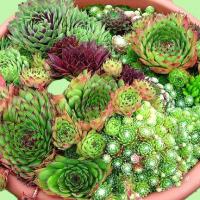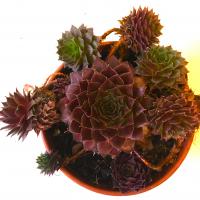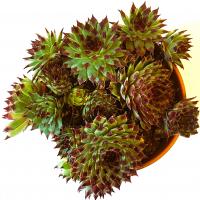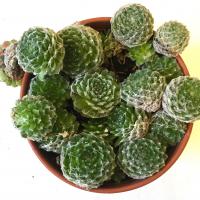Manor Farm Herbs: Unusual herbs
Agrimony

Agrimonia eupatoria
Includes carriage & specialist packaging
Also known as:
Aaron's rod, Church steeples, Clot-bur, Sweethearts, Money-in-both-pockets,
Fairy's wand, Salt-and-pepper.
This is a hairy leaf perennial herb with tall slender spikes of golden yellow flowers in mid summer.
It can be seen growing wild in grassy habitats and is great to grow in the garden near the base of
hedges and the edges of wooded areas. It will establish and naturalise in lawns and wildflower
areas.
Alpine Strawberry

Fragaria vesca 'Alexandria'
Includes carriage & specialist packaging
This is a popular perennial herb with white flowers and small scarlet berries and a delicious flavour. Cultivated alpine strawberries, unlike their wild relatives, do not produce runners and so are not invasive when planted in the border.
Alpine Strawberry 'White Soul'

Fragaria vesca 'White Soul'
Includes carriage & specialist packaging
An interesting form of a perennial favourite with traditional strawberry shaped evergreen leaves. Alpine strawberry 'White Soul' has prolific white flowers followed by white/creamy coloured fruits over a long period from June to October.
Click here for more information about Alpine Strawberry 'White Soul'

Angelica

Angelica archangelica
Includes carriage & specialist packaging
This is a large strong growing herb that can be grown either as a short-lived perennial or as a biennial. It is a fine architectural plant with large bright green leaves and creamy white, fragrant flower heads. Due to its height and spread it makes a elegant feature at the back of the border.
Angelica sylvestris 'Ebony' (Vicar's mead)

Angelica sylvestris 'Purpurea'
This is a tall biennial/perennial herb with very dark purple, glossy divided foliage. In its second year, dark purple buds open into umbels of pink flowers in late summer – these are very popular with pollinators.
Click here for more information about Angelica sylvestris 'Ebony' (Vicar's mead)

Anise hyssop - Mexican
(Bee balm, Mexican giant hyssop)

Agastache mexicana 'Lime'
Includes carriage & specialist packaging
This is a versatile perennial herb. The bright foliage is topped with spires of purple flowers in summer, which are a magnet to bees and other pollinators. A great culinary herb popular in drinks with additional medicinal uses.
Click here for more information about Anise hyssop - Mexican
(Bee balm, Mexican giant hyssop)

Artemesia 'Cola Plant'

Artemesia abrotanum 'Cola Plant' - A cultivar of the more common Southernwood
Includes carriage & specialist packaging
This is a hardy herbaceous shrub which can reach 1.5 m in height, with silvery-green foliage and yellow flowers. As the name suggests the young tips both smell and taste of Cola, and can be used as a culinary herb in sauces, salads, roasts and drinks.
Click here for more information about Artemesia 'Cola Plant'

Bergamot Red (Oswego tea or Bee balm)

Monarda didyma
Includes carriage & specialist packaging
This is a tall aromatic perennial herb which makes a great plant for the border. Brightly coloured scarlet flowers, along with their red/green bracts are produced in whorls from July until October. The aroma from the leaves resembles that of the bergamot orange which inspires its name. The foliage is used in herb teas.
Click here for more information about Bergamot Red (Oswego tea or Bee balm)

Bergamot Pink (Oswego Tea or Bee Balm)

Monarda didyma
Includes carriage & specialist packaging
Pink bergamot is a tall upright perennial which makes a great addition to any border. The aroma of the leaves resembles the bergamot orange, hence its name. Whorls of rose pink flowers last from July to September, and attract plenty of pollinators to the garden.
Click here for more information about Bergamot Pink (Oswego Tea or Bee Balm)

Bergamot 'Apple Blossom' (Oswego tea or Bee balm)

Monarda didyma
Includes carriage & specialist packaging
This is a lower growing bergamot with foliage which is very resistant to the mildew that affects many of these plants. As the name suggests Apple Blossom has large, prolific flowers of an attractive pale pink and looks great planted either in the border / herb garden or in large containers.
Click here for more information about Bergamot 'Apple Blossom' (Oswego tea or Bee balm)

Bugle Burgundy Glow (Bugle weed)

Ajuga reptans 'Burgundy Glow'
Includes carriage & specialist packaging
Bugle is an attractive and hardy ground cover perennial herb. Burgundy Glow has lovely multicoloured foliage with the grey-green background accentuated with splashes of burgundy and rose, and a cream margin to the leaves. It blooms in spring and early summer with upright spires of bright blue flowers.
Click here for more information about Bugle Burgundy Glow (Bugle weed)

English Mace

Achillea ageratum (syn decolorans)
Includes carriage & specialist packaging
English mace is a hardy perennial herb with finely divided fern-like foliage, which is vividly green and aromatic. Strong stems carry many small creamy white flowers in the summer.
Caraway (Meridian fennel, Persian cumin)

Carum carvi
Includes carriage & specialist packaging
Caraway is an aromatic herb with feathery foliage, most often grown for the attractive flowers and useful seeds. It is termed a herbaceous biennial which means, in layman terms, that it takes 2 years to produce the seeds, the foliage dies back completely after the first year’s growth re-growing the next spring to flower.
Click here for more information about Caraway (Meridian fennel, Persian cumin)

Cardoon

Cynara cardunculus
Includes carriage & specialist packaging
Cardoons are very closely related to globe artichokes.
They are grown for their silver serrated architectural foliage, making a bold statement at the back of the border or herb garden.
Both the leaves and the unopened flower buds can be harvested for culinary purposes and they have extensive medicinal uses.
Lawn Chamomile

Chamaemelum nobile ‘Treneague’
Includes carriage & specialist packaging
Chamomile is a creeping evergreen perennial herb, with strongly scented foliage. ‘Treneague’ is a non-flowering form ideally suited to growing as a lawn or planting as a 'growing seat'.
Double Flowering Chamomile

Chamaemelum nobile 'Flore Pleno'
Includes carriage & specialist packaging
Flowering chamomile is similar to the cultivar 'Treneague' in habit and scent, but it also produces masses of creamy white daisy flowers in mid summer. It is a very good evergreen ground cover plant.
Click here for more information about Double Flowering Chamomile

Roman Chamomile (English or Garden Ch.)

Chamaemelum nobile
Includes carriage & specialist packaging
This is a flowering chamomile which is perfect for a sunny well drained area. It forms a dense mat of aromatic, creeping foliage with single white daisy flowers in summer. Roman chamomile is excellent planted between patio paving stones and makes a great chamomile lawn, needing little regular maintenance — just a trim 2 or 3 times a year.
Click here for more information about Roman Chamomile (English or Garden Ch.)

Chicory

Cicorium intybus
Includes carriage & specialist packaging
Chicory is a leafy perennial herb, which reaches up to 1.4m high when flowering. Flower spikes arise from a clump of foliage from mid summer onwards and florets of the most perfect sky blue are arranged along them.
Cowslip

Primula veris
Includes carriage & specialist packaging
Cowslips are spring flowering, clump forming perennials. Whilst they are becoming increasingly rare in the wild they are easy to grow in the garden with attractive green oval shaped leaves and deep yellow scented flowers.
Curry Plant

Helichrysum italicum (syn. angustifolium)
Includes carriage & specialist packaging
Curry plant is an attractive shrub with aromatic silver coloured foliage. Bright yellow, flat heads of flowers appear in summer and the whole plant smells strongly of curry especially after rain.
Echinacea - Purple cone-flower

Echinacea purpurea (Rudbeckia purpurea)
This is an ornamental, free flowering perennial herb, the daisy like flowers are large and purple coloured with orange cone shaped centres.
Click here for more information about Echinacea - Purple cone-flower

Good King Henry

Chenopodium bonus-henricus
Good King Henry is a hardy perennial herb with succulent shield shaped leaves. It has many other names such as Lincolnshire spinach, Fat Hen or Poor-man's asparagus and has both many culinary and medicinal uses.
Horseradish

Armoracia rusticana
Includes carriage & specialist packaging
Horseradish is a stout, upright perennial with vigorous spreading tendencies. It has long leaves up to 50cm long and racemes of tiny white flowers in summer. Home-made horseradish sauce is so superior to the shop bought variety that once tasted you will never buy it again!
NEW Houseleeks (Hen and chicks, liveforever) NEW

Sempervivum tectorum
You may choose from the three varieties below — see the individual pages for prices and ordering:
Red houseleek – Sempervivum tectorum 'Rubin'
A bright red coloured rosette
Red tipped houseleek – Sempervivum tectorum 'Calcareum'
A green rosette with bold red tips to each leaf
Spider web houseleek – Sempervivum tectorum 'Arachnoides'
A pale green houseleek covered in an attractive web of fine silvery hairs
Click here for more information about Houseleeks (Hen and chicks, liveforever)

NEW Red Houseleek 'Rubin' NEW

Sempervivum tectorum 'Rubin'
Includes carriage & specialist packaging
A bright red coloured rosette
Houseleeks are easy to grow perennial succulents and form dense tufted mats which will flower in
summer after a year or so of growth. They reproduce by forming new rosettes all around the edge of
the original plant, which you can either remove and reroot elsewhere or leave in situ to allow the
area covered to increase in size.
Our online plants are shipped as bare rooted — no pots.
Houseleeks only produce minimal roots so it is not feasible to ship successfully in a pot with compost.
They are ready for you to plant in a position of your choice by pushing them into a shallow indentation in the soil surface,
where they will happily root away.
Do bear in mind that houseleeks can alter in colour throughout the year with the temperature and light levels.
NEW Red tipped houseleek 'Calcareum' NEW

Sempervivum tectorum 'Calcareum'
Includes carriage & specialist packaging
A green rosette with bold red tips to each leaf
Houseleeks are easy to grow perennial succulents and form dense tufted mats which will flower in
summer after a year or so of growth. They reproduce by forming new rosettes all around the edge of
the original plant, which you can either remove and reroot elsewhere or leave in situ to allow the
area covered to increase in size.
Our online plants are shipped as bare rooted — no pots.
Houseleeks only produce minimal roots so it is not feasible to ship successfully in a pot with compost.
They are ready for you to plant in a position of your choice by pushing them into a shallow indentation in the soil surface,
where they will happily root away.
Do bear in mind that houseleeks can alter in colour throughout the year with the temperature and light levels.
Click here for more information about Red tipped houseleek 'Calcareum'

NEW Spider web houseleek 'Arachnoides' NEW

Sempervivum tectorum 'Arachnoides'
Includes carriage & specialist packaging
A pale green houseleek covered in an attractive web of fine silvery hairs
Houseleeks are easy to grow perennial succulents and form dense tufted mats which will flower in
summer after a year or so of growth. They reproduce by forming new rosettes all around the edge of
the original plant, which you can either remove and reroot elsewhere or leave in situ to allow the
area covered to increase in size.
Our online plants are shipped as bare rooted — no pots.
Houseleeks only produce minimal roots so it is not feasible to ship successfully in a pot with compost.
They are ready for you to plant in a position of your choice by pushing them into a shallow indentation in the soil surface,
where they will happily root away.
Do bear in mind that houseleeks can alter in colour throughout the year with the temperature and light levels.
Click here for more information about Spider web houseleek 'Arachnoides'

Lemon Balm (common balm, balm mint)

Melissa officinalis
Includes carriage & specialist packaging
Lemon balm, as the name suggests, has bright green lemon scented foliage — rather like large mint leaves to which it is closely related. Small, white, nectar rich flowers appear in mid summer which are very attractive to bees. A great culinary herbs with many uses.
Click here for more information about Lemon Balm (common balm, balm mint)

Lemon Grass

Cymbopogon citratus
Includes carriage & specialist packaging
Lemon grass is a tropical herb widely used in oriental cooking and with many other uses. This plant produces an arching fountain of foliage with the edible part as a swollen base to each stem. As it is a native of a hot climate it is best grown in a large container and brought indoors before it gets cold in winter where it makes an attractive conservatory plant.
Lemon Verbena

Aloysia citriodora (Lippia triphylla)
Includes carriage & specialist packaging
Lemon verbena is a slightly tender perennial shrub with long pointed leaves, and the best lemon
scent in the ‘herb world’, giving it lots of culinary uses.
With an elegant shape and lots of lemony aroma to the foliage, this is a great herb to grow near
outdoor living areas.
Lemon verbena 'Golden Wind'

Aloysia citriodora 'Golden Wind'
Lippia triphylla 'Golden Wind'
Includes carriage & specialist packaging
A brand new variety of the popular lemon verbena. It has the same great aromatic foliage as the common Lippia but with pure golden leaves. A statement plant for a container!
Click here for more information about Lemon verbena 'Golden Wind'

Lovage

Levisticum officinale
Includes carriage & specialist packaging
Lovage is a tall celery flavoured perennial with large green leaves and tiny yellow flowers. It is one of the earliest herbs to appear in the spring and its flavoursome leaves are welcome in the kitchen.
Marshmallow

Althaea officinalis
Marshmallow is a beautiful tall garden herb which is covered in pink flowers in summer rather like a smaller version of Lavatera. Yes, the sweets were originally made from this perennial plant, prepared from the roots which are particularly mucilaginous!
Sweet Violet

Viola odorata
Includes carriage & specialist packaging
Violets are a well known native woodland herb with dark green, heart-shaped leaves and small, sweetly scented dark blue flowers. The herb is easy to grow in most soils and situations and the flowers and leaves have a multitude of culinary, medicinal and cosmetic uses.
Wild or Perennial Rocket

Diplotaxis tenuifolia
This perennial form of rocket is becoming increasingly popular as a home-grown salad herb. Unlike salad rocket, an annual that readily goes to seed, the perennial variety can be cut over and over again, year after year.
Click here for more information about Wild or Perennial Rocket

Salad Burnet

Sanguisorba minor
Includes carriage & specialist packaging
Salad burnet is a perennial herb with a fountain of bright green divided foliage and small 'bottle brush' flowers in summer. The leaves have a distinct cucumber flavour.
Winter Savory

Satureia montana
Includes carriage & specialist packaging
Winter Savory is an easy to grow, perennial shrub with little pointed green leaves, which have a spicy, peppery flavour. This is a good versatile herb with many uses and well deserving of a place in the herb garden.
Creeping Savory

Satureja spicigera (Satureja repanda)
Includes carriage & specialist packaging
This is a low growing form of savory with aromatic dark green leaves, and whorls of pure white flowers later in the summer. As well planting in the herb garden as a culinary herb, creeping savory looks good planted alongside our popular creeping thyme range, extending the flowering season and adding another colour variation to the pinks and reds of the thyme.
Red Veined Sorrel

Rumex sanguineus
This is an easy-to-grow perennial herb with a distinctive tangy lemony flavour, used in salads and soups, and also as baby leaf for 'cut and come again' salad production. It has unusual and striking foliage - light green leaves with blood red veining, making it as attractive in the garden as on the plate.
Broad leaved Sorrel

Rumex acetosa
Sorrel has large bright green leaves held on strong stalks, and looks similar to spinach. The inconspicuous reddish flowers are best removed. It is grown for the fine lemony flavour of the leaves.
Sweet Cecily (Garden Myrrh)

Myrrhis odorata
Includes carriage & specialist packaging
This is an easy to grow herbaceous perennial with pretty feathery fern like leaves up to 40cm long. Umbels of frothy white flowers appear in late spring, followed by large ridged green seeds which turn dark brown as they ripen. The leaves, shoots and seeds have a sweet anise flavour and are excellent to use in many ways.
Click here for more information about Sweet Cecily (Garden Myrrh)

Sweet Woodruff

Galium odoratum
Includes carriage & specialist packaging
Woodruff is a low growing and spreading herbaceous perennial with attractive whorls of leaves up the stems. It flowers in late spring and the delicate flower heads are made up of lots of tiny white florets with a sweet scent.
Variegated Landcress

Barbarea vulgaris 'Variegata'
Landcress is a very hardy and attractive perennial herb and the variegated form has bold splashes of cream all over the dark green leaves. It is grown as a salad herb, the leaves have a peppery flavour similar to watercress.
Vietnamese coriander

Persicaria odorata
Includes carriage & specialist packaging
Also known as Vietnamese mint, Cambodian mint, Hot mint or Laksa leaf, it is a tropical perennial whose leaves are widely used in the South East Asian cooking. The leaves have a strong citrus aroma and taste, similar to coriander but lemony and spicy as well.
Wood Sage (Woodland Germander)

Teucrium scorodonia
Includes carriage & specialist packaging
Wood sage is one of our favourite herbs. Closely related to Germander and Lamium it has green wrinkled downy leaves and very attractive yet subtle, greenish yellow flowers from July onwards. It is an easy to grow native perennial, spreading to make a good sized clump and is very attractive to bees when in flower.
Click here for more information about Wood Sage (Woodland Germander)

Germander Caucasian (Iranian Germander)

Teucrium hircanicum
Includes carriage & specialist packaging
This is an unusual and overlooked perennial herb with aromatic semi-evergreen foliage, which forms a clump. Ideal for ground cover and suppressing weeds. Candle-like spires of showy purple flowers are a blaze of colour from June until September. Great for mid-summer colour, pollinators, cutting and drying.
Click here for more information about Germander Caucasian (Iranian Germander)
